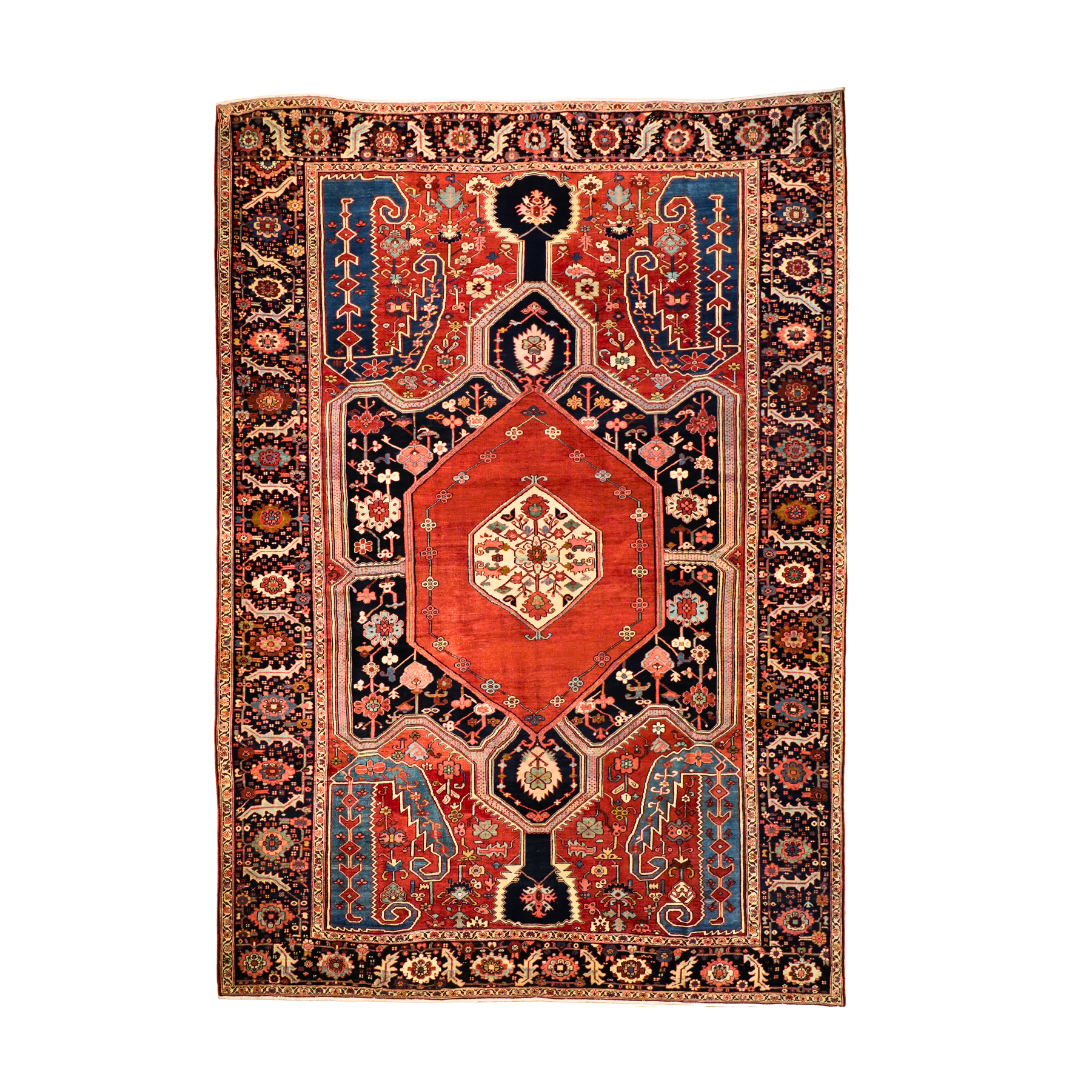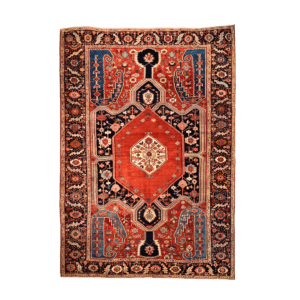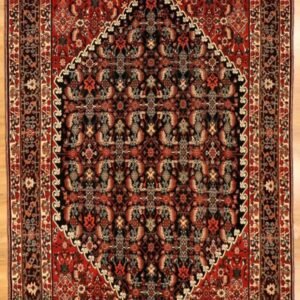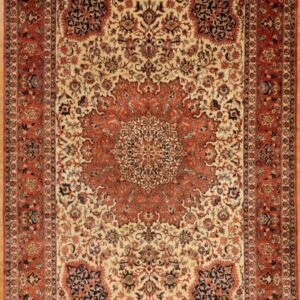Serial No.: 0009626
Origin: Persia, Heriz
Age: Late 19th Century
Style: Tribal Weaving
Size: 10′ 3 x 14′ 7
Material: Wool Foundation, Wool Pile, Vegetable Dyes
Color Scheme: Burgundy, Ivory, Salmon, Turquoise, Navy
Provenance & Historical Context
This late 19th-century rug, measuring 10’3″ x 14’7″, originates from the Serapi weaving tradition of northwest Persia. Serapi rugs are closely associated with the Heriz district, located in the East Azerbaijan province near the slopes of Mount Sabalan. The region’s unique geology, particularly its copper-rich water sources, has long been credited with producing exceptionally robust wool fibers. By the late 19th century, Heriz and surrounding villages—including those identified as Serapi-producing areas—were celebrated for crafting some of Persia’s most sought-after carpets.
Distinguishing Serapi from Heriz
While Heriz rugs are known for their bold medallions and thick, durable construction, Serapi rugs represent an earlier or more refined aesthetic within the Heriz family. They often exhibit:
- Finer Weave & More Open Designs: Serapi rugs typically feature a lower knot density than city rugs, yet still more refined than later Heriz pieces. Their motifs are slightly more spaciously arranged, lending a sense of clarity and grace to the overall layout.
- Softer Color Contrasts: Although both styles favor warm reds, blues, and earthy accents, Serapi pieces often showcase a gentler, more nuanced palette. The burgundy, ivory, salmon, turquoise, and navy scheme here is characteristic of older Serapi rugs, which commonly used softer or “dustier” tones than the bolder, high-contrast Heriz rugs of the early 20th century.
- Earlier Weaving Era: Serapi rugs are typically attributed to the late 19th century or transitional periods, reflecting a more classical approach to design. Later Heriz rugs frequently adopt more angular motifs and starker color transitions.
Weaving & Dyeing Process
Weaving Technique
Crafted on a wool foundation with a wool pile, this rug employs symmetrical (Turkish) knotting, ensuring both durability and crisp pattern delineation. The mountainous terrain around Heriz (including the Serapi-producing villages) contributed to the high lanolin content in local sheep’s wool, making these rugs particularly resilient and lustrous.
Vegetable-Based Dyes
The color scheme—burgundy, ivory, salmon, turquoise, and navy—derives from natural, vegetable-based dyes. Madder root supplies the reds and burgundies, indigo yields the blues, and various plant extracts produce the soft greens and yellows. Over time, these dyes develop a mellow patina, prized by collectors for its organic beauty and historical authenticity.
Locating Heriz & Cultural Significance
Heriz lies in East Azerbaijan, northwest Persia, where the volcanic soils and mineral-rich water reportedly imbue the wool with extraordinary tensile strength. Historically, weaving was an essential livelihood in the region, with many families operating handlooms in their homes. Serapi rugs represent an apex of this local craft, bridging a folk-art ethos with refined design principles.
Areas of Use & Historical Adaptations
Floor Covering
Traditionally, large Serapi rugs like this one were placed in reception halls or grand living quarters, symbolizing status and hospitality. Their robust wool pile withstood significant foot traffic, ensuring longevity.
Wall Hanging
In some households, especially among affluent families or for ceremonial occasions, richly colored rugs were displayed on walls, both for aesthetic appreciation and as protective insulation against cold stone walls. This practice underscored the rug’s dual role: functional floor covering and emblem of cultural artistry.
Modern Applications
Today, this 10’3″ x 14’7″ Serapi can anchor a spacious living room or dining area, blending easily with both traditional and eclectic decor. For those who wish to emphasize its artistic heritage, hanging it on a large, prominent wall transforms it into a tapestry-like focal point, showcasing its intricate motifs and storied past.
In essence, this Serapi rug exemplifies the finest elements of tribal weaving in late 19th-century Persia, combining robust Heriz construction with the more delicate aesthetics of Serapi design. Its carefully balanced palette, intricate motifs, and historically significant weaving techniques render it an heirloom-quality piece—one that carries forward the cultural legacy of Heriz and remains equally compelling in contemporary interior design.







Reviews
There are no reviews yet.